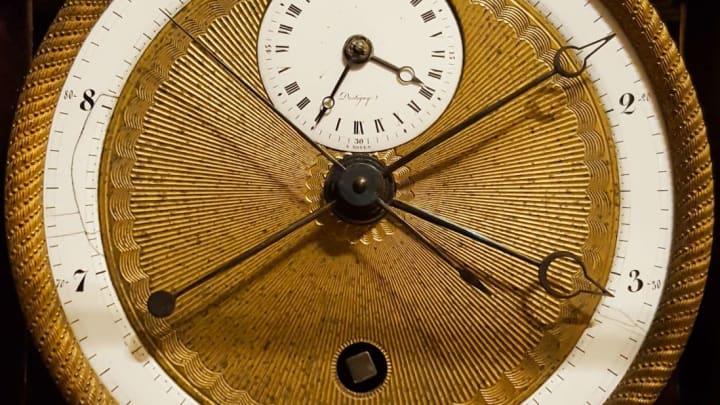Everybody knows that there are 24 hours in a day, 60 minutes in an hour, and 60 seconds in minute.* But in 1793, the French smashed the old clock in favor of French Revolutionary Time: a 10-hour day, with 100 minutes per hour, and 100 seconds per minute. This thoroughly modern system had a few practical benefits, chief among them being a simplified way to do time-related math: if we want to know when a day is 70 percent complete, decimal time simply says "at the end of the seventh hour," whereas standard time requires us to say "at 16 hours, 48 minutes." French Revolutionary Time was a more elegant solution to that math problem. The trick was that every living person already had a well-established way to tell time, and old habits die hard.
Noon is at Five in Decimal Time
French Revolutionary Time officially began on November 24, 1793, although conceptual work around the system had been going on since the 1750s. The French manufactured clocks and watches showing both decimal time and standard time on their faces (allowing for conversion and confusion).
The system proved unpopular. People were unfamiliar with switching systems of time, and there were few practical reasons for non-mathematicians to change how they told time. (The same could not be said of the metric system of weights and measurements, which helped to standardize commerce; weights and measurements often differed in neighboring countries, but clocks generally did not.) Furthermore, replacing every clock and watch in the country was a spendy proposition. The French officially stopped using decimal time after just 17 months: French Revolutionary Time became non-mandatory starting on April 7, 1795. This didn't stop some areas of the country from continuing to observe decimal time, and a few decimal clocks remained in use for years afterwards, presumably leading to many missed appointments.
Other Attempts at Decimal Time
The French Republican Calendar was another attempt by revolutionary France to decimalize everything. It wasn't particularly successful.
The French tried again in 1897, when the Commission de Décimalisation du Temps proposed a 24-hour day with 100-minute hours, again with 100 seconds per minute. This proposal was scrapped in 1900.
And then, of course, there's the Stardate, a pseudo-decimal system of date measurement used in Star Trek. Unsurprisingly, the Stardate started out being supremely imprecise and was just supposed to sound futuristic; here's a snippet from the Star Trek Guide for teleplay writers on the original series:
"Pick any combination of four numbers plus a percentage point, use it as your story's stardate. For example, 1313.5 is twelve o'clock noon of one day and 1314.5 would be noon of the next day. Each percentage point is roughly equivalent to one-tenth of one day."
And lest we forget Swiss watchmakers in all of this, Swatch introduced their own bizarre decimal time system in 1998. Called Swatch Internet Time, it divided the day into ".beats" (yes, with a dot) and referred to a particular .beat using the @ symbol (so you might say, "ICQ me at @484 so we can swap some beenz, LOL!"). Each .beat lasted 1 minute and 26.4 seconds and represented 1/1000 of a day. Nope, not confusing @all.
* = There are actually several exceptions to the 24/60/60 rule, most notably leap seconds, but let's keep it simple.
A version of this story ran in 2013; it has been updated for 2021.
